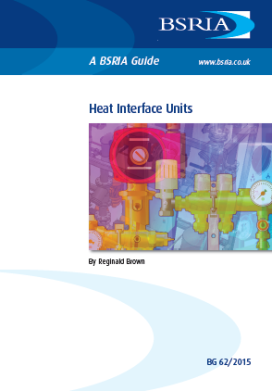BSRIA guide to heat interface units
In December 2015, BSRIA launched a new BSRIA Guide, Heat Interface Units BG 62/2105 written by Reginald Brown with the help of an industry steering group. It is intended for use by specifiers, designers and installers of heating systems served by communal or district heat networks.
The guide defines heat interface units (HIU) as ‘…the means of connection of the consumer’s heating and hot water systems to a heat network and may include isolation and control valves, heat exchangers, pumps and metering devices.’
The guide focuses on the application and installation of direct and indirect heat interface units for residential and small commercial applications within district and communal heat networks. It suggests that installing a HIU linked to a district or communal heat network rather than a conventional boiler can have significant economic and environmental benefits, but that successful operation depends on appropriate system design and specification, and competent installation and maintenance.
The contents of the guide include:
- Introduction.
- Definitions.
- Efficient use of heat networks.
- Designing for HIU’s.
- Heating systems using direct HIU’s.
- Heating systems using indirect HIU’s.
- Domestic hot water.
- Heat metering.
- Acceptance testing.
- Regulations.
- Appendices.
It does not deal with economic assessment, selection of heat sources or detailed design. Guidance on the selection of heat sources and the design and implementation of heat networks is provided by CIBSE’s 2015 Heat Networks: Code of Practice for the UK(CIBSE/ADE CP1), and BSRIA/UKDEA BG 69/2016 (available early 2016).
The BSRIA Heat Interface Units guide is also available to buy as part of a set with CIBSE/ADE CP1.
Catherine England, BSRIA Marketing Officer, said, “Heat networks are not a new idea. However, over the past 20 years there is increasing recognition that heat networks, enabled by the use of HIUs, particularly those associated with combined heat and power systems in urban areas, are a key element of a low carbon future.”
--BSRIA
[edit] Find out more
[edit] Related articles on Designing Buildings Wiki
- A technical guide to district heating (FB 72).
- Allowable solutions.
- Big growth in district heating markets - now and on the horizon.
- Biomass boiler.
- CHP boiler.
- Combined heat and power.
- District energy networks
- Domestic micro-generation.
- Geothermal energy.
- Heat exchanger.
- Heat interface unit.
- Heat Networks Investment Project HNIP.
- Heat pump.
- National heat map.
- Renewable energy.
- Smart cities.
- Types of domestic boiler.
- Water source heat map.
Featured articles and news
Infrastructure that connect the physical and digital domains.
Harnessing robotics and AI in challenging environments
The key to nuclear decommissioning and fusion engineering.
BSRIA announces Lisa Ashworth as new CEO
Tasked with furthering BSRIA’s impressive growth ambitions.
Public buildings get half a million energy efficiency boost
£557 million to switch to cleaner heating and save on energy.
CIOB launches pre-election manifesto
Outlining potential future policies for the next government.
Grenfell Tower Inquiry announcement
Phase 2 hearings come to a close and the final report due in September.
Progress from Parts L, F and O: A whitepaper, one year on.
A replicated study to understand the opinion of practitioners.
ECA announces new president 2024
Electrical engineer and business leader Stuart Smith.
A distinct type of countryside that should be celebrated.
Should Part O be extended to existing buildings?
EAC brands heatwave adaptation a missed opportunity.
Definition of Statutory in workplace and facilities management
Established by IWFM, BESA, CIBSE and BSRIA.
Tackling the transition from traditional heating systems
59% lack the necessary information and confidence to switch.
The general election and the construction industry
As PM, Rishi Sunak announces July 4 date for an election.
Eco apprenticeships continue help grow green workforce
A year after being recognised at the King's coronation.
Permitted development rights for agricultural buildings
The changes coming into effect as of May 21, 2024.























